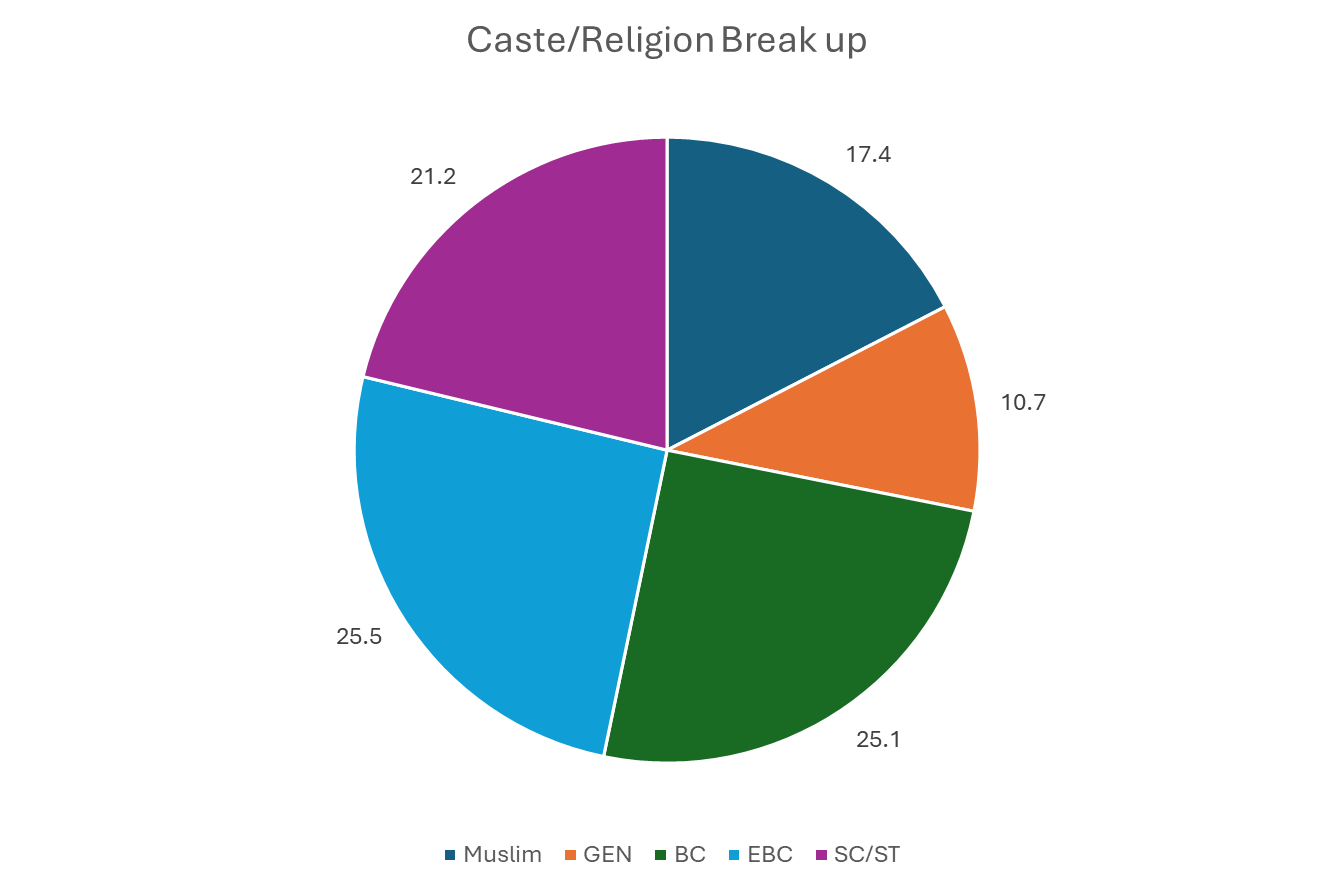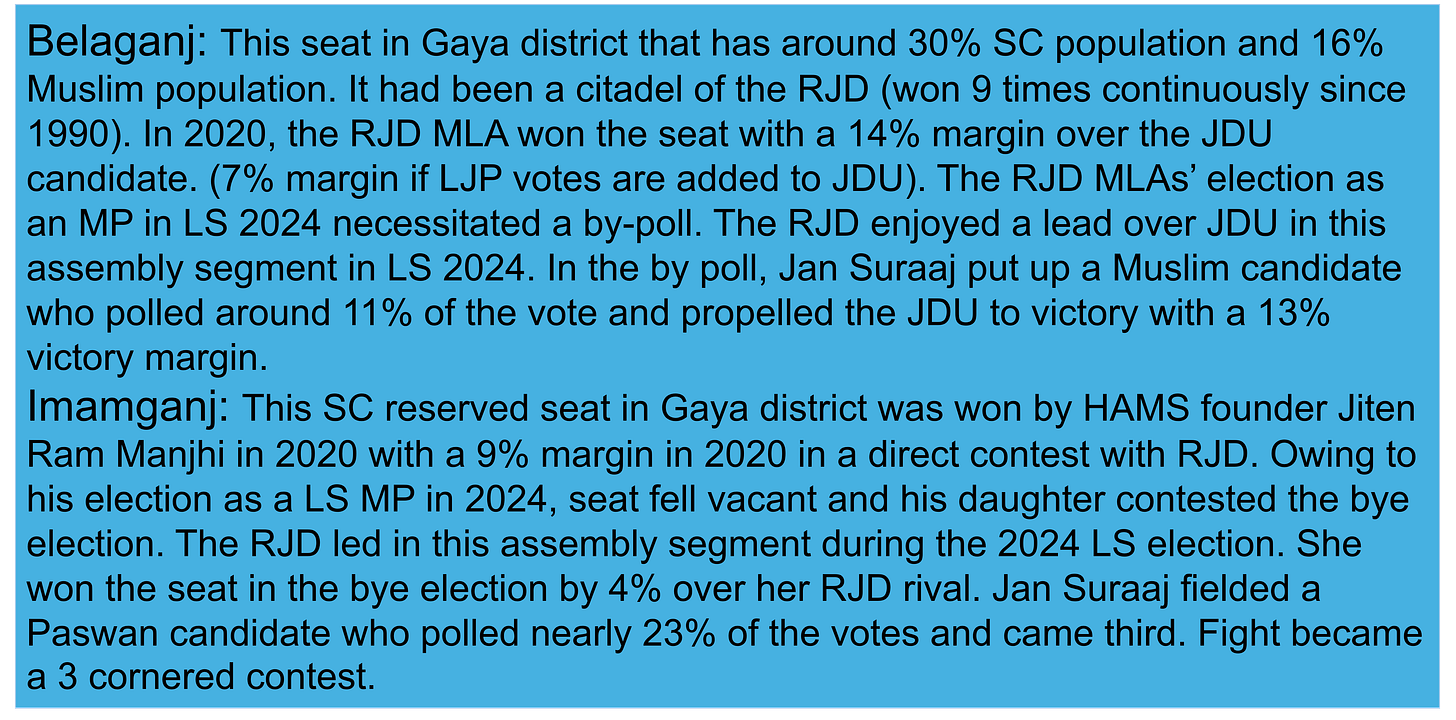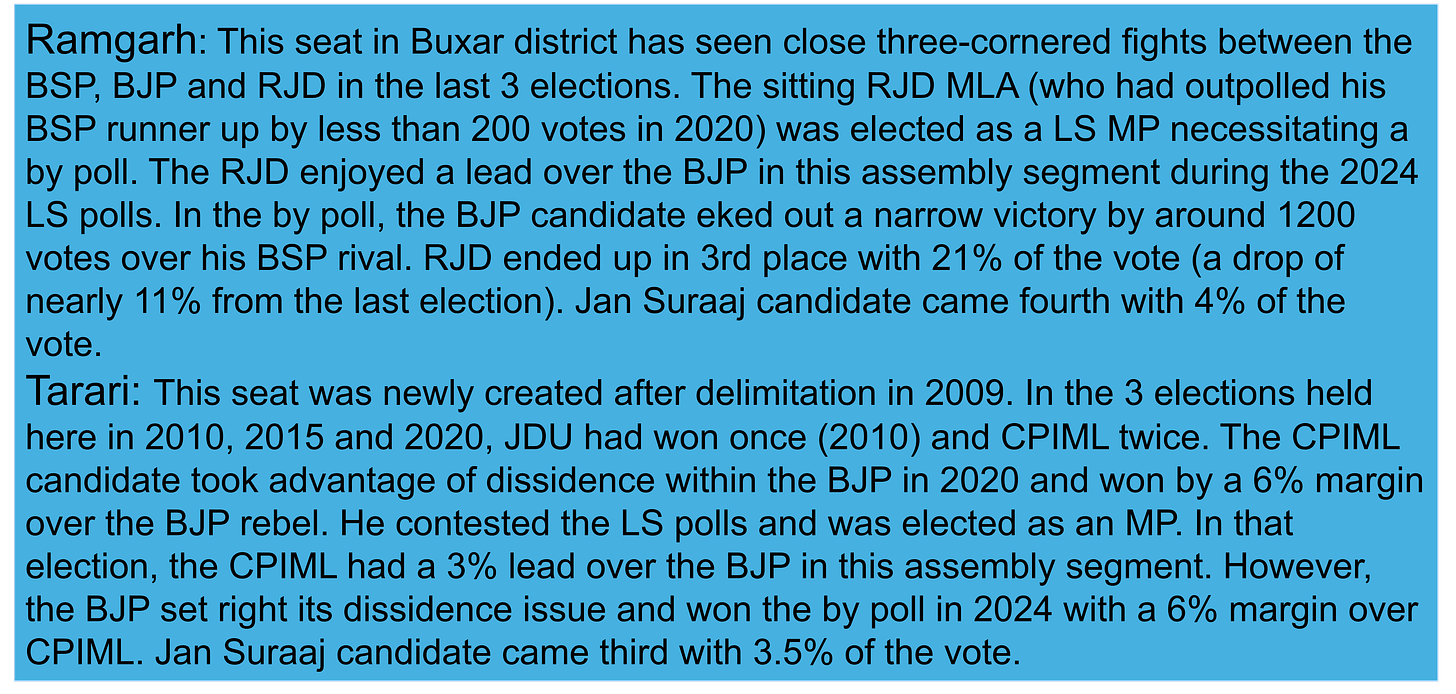Background
In Part 1, I examined Bihar's political regions and demography. I recap the caste/religion breakup of Bihar’s population1 below. Looking at Bihar's past elections, political influence has shifted from upper castes (~10%) to backward castes (~25% of population) and lastly to extremely backward castes (EBCs), which make up ~25% of the population. I have classified Bihar's electoral history into three phases: Congress Dominance, the Lalu Era and the Nitish Era.
Electoral History
Congress Dominance 1947-1989
Bihar and Odisha were separated from the Bengal Presidency in 1911. The INC dominated post independence politics and won 3 state elections held in 1952, 1957 and 1967 with vote shares of 41.38%, 42.09% and 41.35% respectively. (No single party since then, save the Janata Party in 1977 has crossed 40% vote share). Even as the Triveni Samaj tried to consolidate backward castes, the INC through its backward caste federation retained broad based support. Bihar was the first state in India to abolish Zamindari (in 1949) weakening, but not eliminating upper caste dominance.
An anti-INC socialist2 came to power in 1967 amid food shortages and overall disillusionment with INC post-China conflict, but lasted less than a year due to internal dissensions. BP Mandal (of Mandal Commission Report fame), and Bhola Paswan became first backward and dalit CMs of Bihar respectively in this year. After new elections in 1969 failed to break the deadlock, 5 unstable governments (supported by INC or opposition) were formed, but all fell owing to party splits, inter/intra party squabbles, and most crucially, backward castes' attempt to take power. Following the euphoria of the 1971 Bangladesh war, the INC won the 1972 elections and ruled for five years. At this stage, the caste composition of Bihar’s assembly was around 40-45% upper caste, 30% backward castes, 20% SC/ST and 5% others. The 1967 Bengali Naxalbari agitation affected Bhojpur, Magadh, and Jharkhand, where organisations like the CPI-ML (which continues to be a force in pockets of Bihar) fomented peasant uprisings and armed revolts against landowners. Caste based private armies of landowners like the Ranvir Sena emerged later in the 1980s to counter the Naxals, resulting in several massacres.
The Janata Party won a landslide victory in 1977 in the wake of the emergency and Bharat Ratna Karpoori Thakur became CM. Absolute prohibition and the Mungeri Lal Commission report giving OBCs reservations were implemented. Internal frictions on the reservation issue led to Karpoori Thakur’s ouster in 1979, and ultimately to the dismissal of the Janata government in 1980 by the Centre. INC returned to power in both 1980 and 1985 elections and completed its full terms, aided by a fractured opposition. In this phase, the caste composition of Bihar’s assembly was around 35% each from upper castes and BCs, 25% from SC/STs and 5% others, thus signalling a political shift.
The Lalu Era 1989-2005
Nationwide anti-INC sentiment (on issues like corruption in defence purchases like Bofors) led to the formation of the Janata Dal government in 1989, which notified the Mandal Commission Report on OBC reservations. Further, Bharat Ratna Shri L.K. Advani announced a Rath Yatra to promote the Ram Janam Bhoomi movement. The INC's inability to regulate the subsequent communal violence in Bhagalpur further sank its reputation in Bihar, especially among Muslims. The 1990 Bihar elections resulted in the formation of a Janata Dal government in Bihar that lasted its full term. Lalu Yadav, aided by a fractured opposition, returned to power in 1995 and 2000 as a messiah of Yadavs and Muslims who approved of his arrest of Shri L.K. Advani during his 1989 Rath Yatra (together, a third of the population). The upper caste dominance in Bihar’s power structure ended, with OBC’s now accounting for 40-45% of MLAs , upper castes 20-25%, SC/ST 25% and EBCs 5-15%. Lalu’s comment “Swarg nahin diya, sur diya”, translating to “I have not given the backwards heaven, only a voice” captures the policy intent of his government. Economic backsliding in this period, deterioration in law and order and the conviction of Lalu Yadav in the fodder scam led to his ouster from power. Despite their 14% population share, Yadavs (including Lalu) made up 25% and 21% of MLAs in 1995 and 2000, respectively, creating resentment among other backward castes. After his 1994 split with Lalu Yadav,Nitish Kumar (a Kurmi) emerged as an alternative backward caste leader due to the backlash against this ‘Yadav hegemony’.
The Nitish Era 2005-
Bihar Assembly elections were held twice in 2005, post the carve out of Jharkhand. While Feb 2005 delivered a fractured mandate, Nitish Kumar came to power post the October 2005 election. By this time, he had united most anti-RJD leaders under his Janata Dal (United) JDU and struck an alliance with the BJP. He has remained in power since then, barring a short interregnum3. In his nine terms as CM, Nitish Kumar and his party the Janata Dal (United) JDU have ruled through coalition governments formed either mostly with the BJP (6 times) or with RJD (3 times). Three key contributors to Nitish’s continued hold on power have been improved law and order (through laws like the Arms Act and reforms in police recruitment and deployment), women focused schemes (reservation of 50% seats at panchayat level, imposition of prohibition etc) and consolidation of extremely backward castes (by giving them a separate 20% quota in panchayat elections and government appointments). Similarly, Nitish Kumar created a strong following among Dalits by classifying more backward Dalits under the ‘Mahadalit’ umbrella in 2007 and provided separate quotas for them4.
Women (who support him on prohibition, dramatic safety improvements, and targeted welfare schemes) and extremely backward castes/Mahadalits (who fear Yadav hegemony and whose political voice has been enhanced through reservations, role in government) have stood by Nitish Kumar for two decades, despite his political somersaults. JDU’s vote share has held for almost 2 decades as seen in table below.
*-In 2020, the LJP contested against JDU in all seats but did not fight BJP contested seats, thereby selectively denting JDU. LJP ended up with 5.66% of the votes, which if added back to JDU tally indicates no dent in its historical popularity.
Key Players
There are 3 key players in the electoral fray in 20255. These are:
National Democratic Alliance: This alliance comprises of 5 parties BJP, JDU, LJP, HAMS and Rashtriya Loktrantik Morcha (RLM). Of these, the LJP and RLM (formerly RLSP) fought separately in 2020 elections. Key leaders and traditional support bases of these parties are listed below. The JDU support base is coveted by all parties even within this alliance, giving rise to friction (like in 2020 with the LJP, RLM) and making seat sharing challenging. Recent statements of Chirag Paswan about personally contesting the 2025 Bihar elections (he is an MP now) have to be seen as muscle flexing before seat sharing talks. Since Nitish Kumar is popular among Kushwahas (Kurmis and Kushwahas are dubbed the Luv-Kush castes), the RLM has had a rocky relationship with the JDU (Upendra Kushwaha was a JDU member). After losing the 2024 LS elections as an NDA candidate, BJP nominated him to the Rajya Sabha to appease the RLM.
INDIA block: This alliance comprises of the RJD, INC, CPIML, CPI, CPIM, VSIP (Vikassheel Insaan Party). The VSIP is an new member this alliance compared to 2020, where it fought as part of the NDA. The VSIP was formed in 2018 by Mukesh Sahani, a bollywood set-designer to consolidate the 22 riverine castes of Bihar into a vote bank, but has found it difficult to expand beyond its founders’ Mallah caste. The CPI and CPIM are marginal players in Bihar and are electorally salient in less than 6-7 seats (in Begusarai and pockets in Mithilanchal). The CPIML is a potent force as we saw in parts of Bhojpur and Magadh with a large cadre base.
Jan Suraaj Party: In 2024, former election strategist Prashant Kishor launched the Jan Suraaj Party. Prashant Kishor's speeches have focused solely on Bihar's economic development and education, while remaining caste neutral. Despite only contesting by polls in 4 seats (see box), the party appears to have affected the opposition alliance more since:
3 seats were won by the opposition, and 1 by the NDA in 2020.
The opposition block led in all 4 assembly segments in LS 2024.
All 4 seats were won by the ruling alliance in by polls in late 2024.
In subsequent speeches, Prashant Kishor has sharply targeted the BJP (especially its state leadership). The relative proportion in which his party draws support from NDA/INDIA bloc will be a key determinant of the result.
We have now looked at the regions, demographics, electoral history and contestants in Bihar. I will conclude next week by analysing the 2020 elections, looking at current election issues and present my projections.
Source: Bihar Government Caste Survey 2022
Comprising Samyukt Socialist Party, Jan Sangh, CPI, Jan Kranti Dal and Praja Socialist Party
For around 280 days in 2014 when he took responsibility for his party’s debacle in 2014 general elections and installed Jiten Ram Manjhi as a CM
This classification was ended in 2018
The BSP is a player in a few seats in Bhojpur region.







